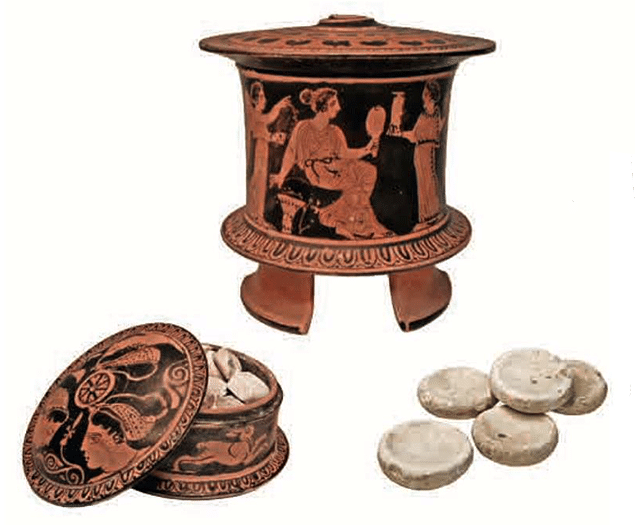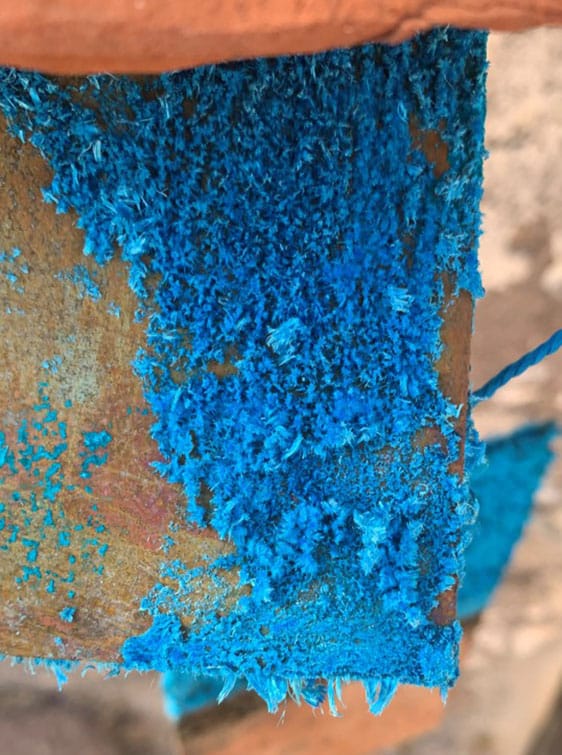Pharmaka Metallica
About pharmaka metallica
It was Galen (2nd c CE) who first coined the term ‘pharmaka metallica’ to denote mineral therapeutics that derived from the mines. He was referring to Cu, Pb, Fe, Ag – based minerals (oxides, carbonates, sulfides, other). He divided them in three groups: a. the naturals (autophyei), used as extracted from the source, b. the ek kaminon, those that derived from the furnaces during a high temperature metallurgical process and c. the skevazomena, the manufactured ones, prepared in the workshop and at ambient temperatures. Amongst the latter he highlighted two, psimythion and ios xystos.
Psimythion—a synthetic lead-based mineral—was manufactured in the Greek world as early as the 6th century BCE and became a well-established material by the 4th century BCE. Described by Theophrastus (On Stones, 56), its production involved suspending metallic lead (Pb) over a fermenting liquid (oxos)( see below), a process that led to the formation of a white powder accumulating on the surface of the metal which was scraped off. The powder consisted of many lead minerals, both soluble and insoluble, the former rinsed off in the process of washing. The result was psimythion, synthetic cerussite, lead carbonate, PbCO₃. It was the forerunner of the famous lead white (synthetic hydrocerussite), widely used in Western art in later periods.
Ios xystos, usually translated as verdigris, involved a similar set up also described by Theophrastus (On Stones, 57). The metal was in this case a copper plate which was suspended over a liquid (tryx); the latter derived from grape pomace soaked in water and allowed to begin to ferment. The blue green powder that formed over the surface of copper and which was scraped off was used extensively as a pigment in the Renaissance and later periods.
Chemical analyses of ancient psimythion pellets found primarily in female burials from the 5th–3rd centuries BCE indicate that these samples contained almost exclusively synthetic cerussite, with only minimal traces of other lead-based phases, like hydrocerussite. This raises an important question: How was near-pure cerussite consistently produced in antiquity? Recently we proposed a working hypothesis regarding the reactions- both biotic, and abiotic- that could have taken place within the Theophrastus pot.

About oxos
Oxos was one of the two ingredients in the making of psimythion. More importantly, oxos was a key reagent in many pharmacological preparations involving mineral therapeutics. Oxos has for long been translated as vinegar. This is, strictly speaking, not correct. The ancient Greeks had another name for vinegar (targanon) and when they wanted to refer to wine that had gone vinegary, they used yet another term, namely oxines oinos (sour wine). So oxos is more accurately translated as ‘poor wine’ rather than as ‘sour wine’. It is oxines oinos that was mixed with water to make oxykraton, a drink used commonly in antiquity. But it was oxos that, the Gospels inform us, the Roman centurion gave to Jesus on the cross.
From agricultural manuals of the 10th c CE we can obtain a number of recipes for making oxos. These recipes actually include both a fermenting liquid (producing alcohol from sugars) and an additional source of sugars (a fruit). The fermenting liquid can be fruit juice, like pressed grapes, or a malted grain like barley, the starches in the latter converting into fermentable sugars. It is the microorganisms within the fermenting liquid and in particular the yeast saccharomyces cerevisiae which are responsible for the generation of enough CO2, in the closed vessel, necessary for the production of lead carbonate.



The dynamic interplay between the fermenting liquid, i.e. the microorganisms within, the gas phase over the liquid, and its reactions with the metal surface, whether copper or lead, drove the mineral synthesis process. The role of oxos not only as a driver of mineral synthesis, but also in lending bioactivity to the pharmacological preparation deserves further investigation. Understanding these ancient bio-geo-chemical processes sheds considerable light into early biotechnological practices.
At AnBioMin, we continue to explore these complex interactions, seeking to reconstruct and understand the forgotten innovations of antiquity.
References
Photos-Jones, E. , Bots, P., Oikonomou, E., Hamilton, A. and Knapp, C.W. (2020) On metal and ‘spoiled’ wine: analysing psimythion (synthetic cerussite) pellets (5th-3rd centuries BCE) and hypothesising gas-metal reactions over a fermenting liquid within a Greek pot. Archaeological and Anthropological Sciences, 12, 243. (doi: 10.1007/s12520-020-01184-1) (PMID:33088349) (PMCID:PMC7560938)
Photos-Jones, E. (2023) Slags reinventing themselves: from metallurgical waste to ingredients in pharmacological applications. In: Nerantzis, N. (ed.) Forging Values: Metals Technologies in the Aegean and Beyond from the 4th to the 1st Millennium BCE. Series: Etude d’archéologie (20). CReA Patrimoine: Bruxelles, pp. 107-112. ISBN 9782960202977